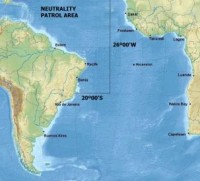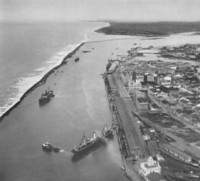THE NEUTRALITY PATROL - NEUTRALITY PATROL
3)THE TASK FORCE THREE
ADMIRAL INGRAM’S TASK FORCE THREE
In early 1941, as British Naval forces continued to battle those of Germany at sea, the U. S. Navy increased its presence in the Caribbean, and within months, in the South Atlantic, as well. On 11 January 1941, Rear Admiral Jonas Howard Ingram, USN hoisted his flag in the light cruiser Memphis (CL 13) at Guantanamo bay, Cuba. This action signified his assuming command of Cruiser Division Two, with the associated designation, command Task Force Three, and additional duty as commander of the Caribbean Patrol.
The patrol had been conducted for months only by the ships of Destroyer Squadron 2, under Capt. Walden L. Ainsworth embarked in the destroyer Moffet (DD-362), and by Patrol Squadron VP-51, twelve PBY Catalina seaplanes under Cmdr. W. J. Mullins, based at San Juan, Puerto Rico. In additionto beefing up ship patrols throughthe assignmentof Cruiser Divison Two, thirty-six seaplanes operating from both San Juan and Guantanamo Bay were now assigned to recconoiter Caribbean Waters from Key West, Florida, to trinidad. As part of this effort, patrol aircraft also maintained surveillance on Vichy French naval forces based at Martinique Island, a French territory in the West Indies.
Cruiser Division Two, consisted of the Memphis, Cincinnati and Miluawkee, all light cruisers, to which the Omaha was later added. Ingram soon saw the advisability of turning over the Caribbean Patrol to the commandant of the Tenth Naval District at San Juan, Puerto Rico, Rear Adm. Raymond A. Spruance. He suggested this action to Adm. Ernest J. King, commander-in-chief Atlantic Fleet, who readily accepted it. Ingram’s release from this responsibility gave him a freer hand for operations in the South Atlantic, to which he was soon assigned.
Ingram visited King in the United States in March 1941. At a meeting on the 24th, Ingram received orders to take Cruiser Division Two to the South Atlantic, on Neutrality Patrol. The Division was to base at San Juan and Guantanamo, and to utilize Recife and Bahia in Brazil as replenishing ports. The area for patrol included the triangle formed by Trinidad, the Cape Verde Islands 350 miles off the northwest coast of Africa, and the hump of Brazil. The old fleet oiler Patoka (AO 9), originally commissioned on 13 October 1919, would serve as tanker, tender and supply vessel for the force.
Admirals King and Ingram both had doubts concerning Brazil and the reception American warships would receive there. King stressed to Ingram that he would have to use initiative and shift for himself in the South Atlantic. The only arrangement made in advance was with the oil companies that would provide his warships with fuel. Ingram commented that so long as there were ships coming out of the Argentine with plenty of foodstuffs, his crews would never starve. King replied that he had Always knew that Ingram was a pirate.
.jpg)
Adm. Ernest King Commander in Chief of the U.S.Fleet and Chief of naval Operations, stopped at Recife on 10 Dec 43 to visit Naval facilities on his return from the historic conference of allied leaders in Africa and the near East. Striding along a street at Recife harbor, Adm. King was flanked by Vice Adm. Jonas Ingram Commander of South Atlantic Fourth Fleet and and Lt Jg D. Frost, USNR (left). Photo. Naval Historical Center.
MAIDEN U. S. NAVY SOUTH ATLANTIC PATROL
Memphis and Cincinnati were the only members of Cruiser Division two immediately available, but since it was deemed necessary to get a patrol into the assigned área at once, Ingram left Newport, Rhode Island, with these ships on 25 April 1941. On 4 May, they reached a point designated as “A” latitude 20º N, longitude 30ºW located a little to the northwest of the Cape Verde Islands. The two cruisers then steamed due South to Point “B” which, located on the equator at longitude 30º West, was off São Paulo (Saint Paul) Rocks belonging to Brazil. They reached this group of small islets and rocks on 8 May. Two days later, the ships entered Recife, a port city in northeast Brazil where the confluence of the Beberibe and Capibaribe Rivers flow into the Atlantic.
Ingram would depart Recife with his two ships the following day, after but a single night in port; but he and other officers were able to learn much about the port during their brief visit. Recife was the third largest city in Brazil, with a population at 400,000. The harbor, though protected by a fine breakwater, was small and narrow, requiring both a pilot and tug for mooring and unmooring. The píer space was good, though restricted to vessels with drafts of twenty-five feet or less. Ships could not enter the harbor at night and, unless moored with their bows toward the entrance, had to leave on a flood tide. Warehouses were available for stores of all kinds, but only limited fresh provisions could be had, chiefly fruits, and there were no dry provisions. On a much brighter note, the fueling facilities proved excelent.

Scene of Recife downtown on early 40's. In 1942 it would be the headquarters of the Fourth Fleet gathering 180 ships from U.S. and Brazilian Navy
The Americans observed, with considerable interest, seven Italian Merchant ships, which had been moored inside the harbor with crews aboard since June 1940, to avoid the possibility of capture at sea. One vessel had a cargo of coal, another grain. The other five ships were empty.
Admiral Ingram also took the opportunity, while at Recife, t olear as much as possible about Bahia, which lay approximately 400 miles to the South. Although Bahia has na excelent natural harbor compared to the poor one at Recife, it was situated a little to far below the shoulder of Brazil to be the best base for patrol work against Axis submarines. It would be developed as a U. S. naval facility, but would remain of secondary importance during the war in comparision to Recife.
Following a reception aboard the Memphis, given by Ingram for Brazilian officials on the morning of Sunday, 11 May, the ships sailed for Port of Spain, Trinidad. They arrived there on the 18th, a day ahead of schedule, having been aided by a 2 knot current of Cape São Roque the point on the bend of the Brazilian coast closest to the continent of Africa.
“Ingram’s Fourth Fleet”. U.S. and Royal Navy operations against German Runners, Raiders and Submarines in the South Atlantic in the World War Two. Cmdr David Bruhn U.S. Navy Ret.

